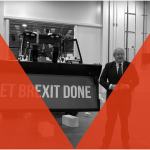
Dr David McQueen
Lecturer in Advertising and Media at Bournemouth University, where he writes about issues of media and power, conflict coverage and PR. He is a long-standing member of the Green Party.
Email: dmcqueen@bournemouth.ac.uk

Section 5: Policy and Strategy
- The uses and abuses of the left-right distinction in the campaign
- Entitlement and incoherence: centrist ‘bollocks’
- Brexit doesn’t mean Brexit, but the pursuit of power
- What ever happened to euroscepticism?
- Immigration in the 2019 General Election campaign
- Immigration in party manifestos: threat or resource?
- Foreign policy in the 2019 election
- Post-Brexit ‘Global Britain’ as the theatre of the New Cold War
- The Rorschach election: how the US narrates UK politics
- If everyone has a mandate… surely nobody has a mandate?
- Is this a climate election (yet)?
- Movement-led electoral communication: Extinction Rebellion and party policy in the media
For the Green Party and the wider green movement, this was billed as the climate election. The climate chaos that scientists and environmentalists had been warning us about for over thirty years was relentlessly dramatised in the news in November and December 2019. The election campaign began against a montage of burning forest in Brazil, ferocious wildfires in California and Australia and the flooding of Venice and its many iconic landmarks at an estimated cost of 1 billion euros. The flooding of Venice Council occurred just minutes after its right-wing majority rejected measures to fight climate change. The image of the regional council debating chamber, located on the Gran Canal, submerged in water on the 12th November, served as a striking metaphor of the inaction of politicians around the world on this issue, a failure that would be repeated on a global scale at Cop 25 in Madrid in December. For Boris Johnson, perhaps the most dangerous moment in the election campaign came on November 13th when he was taken to task by locals in Yorkshire, angered by his slow response to their plight. Had Britain suffered more severe flooding in the weeks that followed Johnson’s heckling in Doncaster, the climate crisis might have made a more significant impact on the debates, but Brexit and the NHS almost completely dominated the headlines until election day.
In fact, the best hope for putting global warming back on the national agenda came on the 28th November when Channel 4’s Krishnan Guru-Murthy hosted a lively one-hour debate on the climate crisis which all the major party leaders attended, except Boris Johnson and Nigel Farage. The studio replaced the no-show politicians with melting ice sculptures of the earth mounted on the Brexit and Conservative Party emblems, which dripped quietly beneath the studio lights. The Conservative Party’s response to what it called a “provocative partisan stunt” was to threaten to review Channel 4’s public service broadcasting licence over a “pattern of bias” and to make an official complaint to Ofcom, which the broadcasting regulator rejected a few days later. Aside from accusations of Trump-like bullying by Channel 4 and others, Boris Johnson was criticised for dodging the climate debate by Sir David Attenborough, who told Channel 4: “I don’t know what else he had to do, but it would have to be very, very important to dodge this one.”
Boris Johnson’s failure to attend the debate was symptomatic of a campaign where the party leader appeared to be evading scrutiny – hiding in a fridge from a Good Morning Britain interview and called out by Andrew Neil for refusing to be interviewed. But aside from the Channel 4 debate, climate change played a relatively minor role in the election – featuring in a Question Time election special with an audience of under-30s – but otherwise making little or no impact on the leaders’ debates and with no questions at all on the subject in the final leaders’ debate. This, despite YouGov polls showing the environment tied with the economy as one of the top four issues facing the country, behind crime, health and leaving the EU.
The Labour Party had stolen some of the Green Party’s thunder on its radical plans for a Green New Deal and was, controversially, judged to offer the greenest plans according to Friends of the Earth. The Green Party certainly saw some of its support drain away to Labour and disputes break out in the Party on the wisdom of their electoral pact with the Liberal Democrats and Plaid Cymru not to stand against each other in some seats, while challenging Labour candidates in marginal constituencies such as Stroud. There, sitting MEP Molly Scott Cato took enough votes to deprive Labour candidate David Drew of a majority and was heckled at her concession speech on election night for allowing the Conservative candidate Siobhan Baillie to take the seat. Scott Cato argued that the Labour Party needed to “respect democracy and the voters’ choice” and there was criticism of Labour for not joining in a ‘defeat Boris’ pact. After the election night landslide results were announced for the Conservative Party, the Greens released an infographic showing that, under proportional representation, Labour would be leading a coalition government with the support of 18 Green MPs. There was also frustration with the first-past-the-post system that despite the Green vote increasing by over 60% (at 850,000 votes) the party still only had one Green MP, Caroline Lucas. The realities of Britain’s electoral system are likely to mean that Greens are massively under-represented in British Parliament compared to their European counterparts and that real action on the climate emergency, including a Green New Deal, may simply come too late.
